Feathered dinosaur
A feathered dinosaur is any species of dinosaur possessing feathers. While this includes all species of birds, recent evidence supports the hypothesis that many, if not all non-avian dinosaur species also possessed feathers in some shape or form. It has been suggested that feathers had originally evolved for the purposes of thermal insulation, as remains their purpose in the down feathers of infant birds today, prior to their eventual modification in birds into structures that support flight.
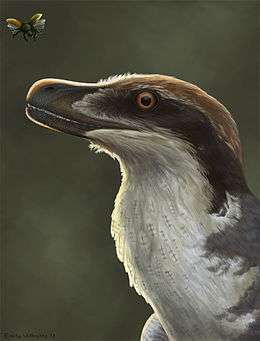
Since scientific research began on dinosaurs in the early 1800s, they were generally believed to be closely related to modern reptiles, such as lizards. The word "dinosaur" itself, coined in 1842 by paleontologist Richard Owen, comes from the Greek for "fearsome lizard". This view began to shift during the so-called dinosaur renaissance in scientific research in the late 1960s, and by the mid-1990s significant evidence had emerged that dinosaurs were much more closely related to birds, which descended directly from the theropod group of dinosaurs[1] and are themselves a subgroup within the Dinosauria.
Knowledge of the origin of feathers developed as new fossils were discovered throughout the 2000s and 2010s and as technology enabled scientists to study fossils more closely. Among non-avian dinosaurs, feathers or feather-like integument have been discovered in dozens of genera via direct and indirect fossil evidence.[2] Although the vast majority of feather discoveries have been in coelurosaurian theropods, feather-like integument has also been discovered in at least three ornithischians, suggesting that feathers may have been present on the last common ancestor of the Ornithoscelida, a dinosaur group including both theropods and ornithischians.[3] It is possible that feathers first developed in even earlier archosaurs, in light of the discovery of highly feather-like pycnofibers in pterosaurs.[4] Crocodilians also possess beta keratin similar to those of birds, which suggests that they evolved from common ancestral genes.[5]
History of research
Early
.jpg)
Shortly after the 1859 publication of Charles Darwin's On the Origin of Species, British biologist Thomas Henry Huxley proposed that birds were descendants of dinosaurs. He compared the skeletal structure of Compsognathus, a small theropod dinosaur, and the 'first bird' Archaeopteryx lithographica (both of which were found in the Upper Jurassic Bavarian limestone of Solnhofen). He showed that, apart from its hands and feathers, Archaeopteryx was quite similar to Compsognathus. Thus Archaeopteryx represents a transitional fossil. In 1868 he published On the Animals which are most nearly intermediate between Birds and Reptiles, making the case.[6][7] The first restoration of a feathered dinosaur was Thomas Henry Huxley's depiction in 1876 of a feathered Compsognathus to accompany a lecture on the evolution of birds he delivered in New York in which he speculated that the aforementioned dinosaur might have been in possession of feathers.[8] The leading dinosaur expert of the time, Richard Owen, disagreed, claiming Archaeopteryx as the first bird outside dinosaur lineage. For the next century, claims that birds were dinosaur descendants faded, with more popular bird-ancestry hypotheses including 'crocodylomorph' and 'thecodont' ancestors, rather than dinosaurs or other archosaurs.
'Dinosaur renaissance'
In 1969, John Ostrom described Deinonychus antirrhopus, a theropod that he had discovered in Montana in 1964 and whose skeletal resemblance to birds seemed unmistakable. Ostrom became a leading proponent of the theory that birds are direct descendants of dinosaurs. Further comparisons of bird and dinosaur skeletons, as well as cladistic analysis strengthened the case for the link, particularly for a branch of theropods called maniraptors. Skeletal similarities include the neck, the pubis, the wrists (semi-lunate carpal), the 'arms' and pectoral girdle, the shoulder blade, the clavicle and the breast bone. In all, over a hundred distinct anatomical features are shared by birds and theropod dinosaurs. Other researchers drew on these shared features and other aspects of dinosaur biology and began to suggest that at least some theropod dinosaurs were feathered.
At the same time, paleoartists began to create modern restorations of highly active dinosaurs. In 1969, Robert T. Bakker drew a running Deinonychus. His student Gregory S. Paul depicted non-avian maniraptoran dinosaurs with feathers and protofeathers, starting in the late 1970s. In 1975, Eleanor M. Kish began to paint accurate images of dinosaurs, her Hypacrosaurus being the first one shown with its camouflage.[9]
Before the discovery of feathered dinosaur fossils, the evidence was limited to Huxley and Ostrom's comparative anatomy. Some mainstream ornithologists, including Smithsonian Institution curator Storrs L. Olson, disputed the links, specifically citing the lack of fossil evidence for feathered dinosaurs. By the 1990s, however, most paleontologists considered birds to be surviving dinosaurs and referred to 'non-avian dinosaurs' (all extinct), to distinguish them from birds (Avialae).
Fossil discoveries
One of the earliest discoveries of possible feather impressions by non-avian dinosaurs is an ichnofossil (Fulicopus lyellii) of the 195-199 million year old Portland Formation in the northeastern United States. Gierlinski (1996, 1997, 1998) and Kundrát (2004) have interpreted traces between two footprints in this fossil as feather impressions from the belly of a squatting dilophosaurid. Although some reviewers have raised questions about the naming and interpretation of this fossil, if correct, this early Jurassic fossil is the oldest known evidence of feathers, almost 30 million years older than the next-oldest-known evidence.[10][11][12]
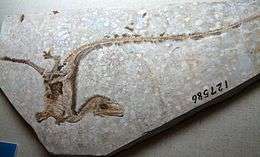
After a century of hypotheses without conclusive evidence, well-preserved fossils of feathered dinosaurs were discovered during the 1990s, and more continue to be found. The fossils were preserved in a Lagerstätte—a sedimentary deposit exhibiting remarkable richness and completeness in its fossils—in Liaoning, China. The area had repeatedly been smothered in volcanic ash produced by eruptions in Inner Mongolia 124 million years ago, during the Early Cretaceous epoch. The fine-grained ash preserved the living organisms that it buried in fine detail. The area was teeming with life, with millions of leaves, angiosperms (the oldest known), insects, fish, frogs, salamanders, mammals, turtles, and lizards discovered to date.
The most important discoveries at Liaoning have been a host of feathered dinosaur fossils, with a steady stream of new finds filling in the picture of the dinosaur–bird connection and adding more to theories of the evolutionary development of feathers and flight. Turner et al. (2007) reported quill knobs from an ulna of Velociraptor mongoliensis, and these are strongly correlated with large and well-developed secondary feathers.[13]
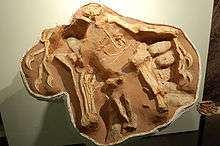
Behavioural evidence, in the form of an oviraptorosaur on its nest, showed another link with birds. Its forearms were folded, like those of a bird.[14] Although no feathers were preserved, it is likely that these would have been present to insulate eggs and juveniles.[15]
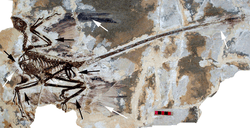
Not all of the Chinese fossil discoveries proved valid however. In 1999, a supposed fossil of an apparently feathered dinosaur named Archaeoraptor liaoningensis, found in Liaoning Province, northeastern China, turned out to be a forgery. Comparing the photograph of the specimen with another find, Chinese paleontologist Xu Xing came to the conclusion that it was composed of two portions of different fossil animals. His claim made National Geographic review their research and they too came to the same conclusion.[16] The bottom portion of the "Archaeoraptor" composite came from a legitimate feathered dromaeosaurid now known as Microraptor, and the upper portion from a previously known primitive bird called Yanornis.
In 2011, samples of amber were discovered to contain preserved feathers from 75 to 80 million years ago during the Cretaceous era, with evidence that they were from both dinosaurs and birds. Initial analysis suggests that some of the feathers were used for insulation, and not flight.[17][18] More complex feathers were revealed to have variations in coloration similar to modern birds, while simpler protofeathers were predominantly dark. Only 11 specimens are currently known. The specimens are too rare to be broken open to study their melanosomes, but there are plans for using non-destructive high-resolution X-ray imaging.[19]
In 2016, the discovery was announced of a feathered dinosaur tail preserved in amber that is estimated to be 99 million years old. Lida Xing, a researcher from the China University of Geosciences in Beijing, found the specimen at an amber market in Myanmar. It is the first definitive discovery of dinosaur material in amber.[20][21][22][23]
In March 2018, scientists reported that Archaeopteryx was likely capable of flight, but in a manner substantially different from that of modern birds.[24][25]
Current knowledge
Non-avian dinosaur species preserved with evidence of feathers
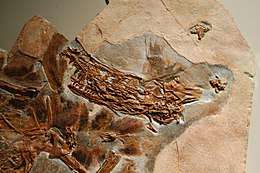
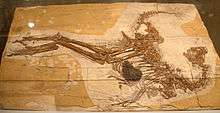
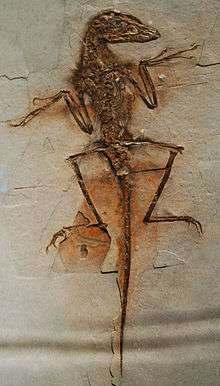
Several non-avian dinosaurs are now known to have been feathered. Direct evidence of feathers exists for several species. In all examples, the evidence described consists of feather impressions, except those genera inferred to have had feathers based on skeletal or chemical evidence, such as the presence of quill knobs (the anchor points for wing feathers on the forelimb) or a pygostyle (the fused vertebrae at the tail tip which often supports large feathers).[26]
Primitive feather types
Integumentary structures that gave rise to the feathers of birds are seen in the dorsal spines of reptiles and fish. A similar stage in their evolution to the complex coats of birds and mammals can be observed in living reptiles such as iguanas and Gonocephalus agamids. Feather structures are thought to have proceeded from simple hollow filaments through several stages of increasing complexity, ending with the large, deeply rooted feathers with strong pens (rachis), barbs and barbules that birds display today.[27]
According to Prum's (1999) proposed model, at stage I, the follicle originates with a cylindrical epidermal depression around the base of the feather papilla. The first feather resulted when undifferentiated tubular follicle collar developed out of the old keratinocytes being pushed out. At stage II, the inner, basilar layer of the follicle collar differentiated into longitudinal barb ridges with unbranched keratin filaments, while the thin peripheral layer of the collar became the deciduous sheath, forming a tuft of unbranched barbs with a basal calamus. Stage III consists of two developmental novelties, IIIa and IIIb, as either could have occurred first. Stage IIIa involves helical displacement of barb ridges arising within the collar. The barb ridges on the anterior midline of the follicle fuse together, forming the rachis. The creation of a posterior barb locus follows, giving an indeterminate number of barbs. This resulted in a feather with a symmetrical, primarily branched structure with a rachis and unbranched barbs. In stage IIIb, barbules paired within the peripheral barbule plates of the barb ridges, create branched barbs with rami and barbules. This resulting feather is one with a tuft of branched barbs without a rachis. At stage IV, differentiated distal and proximal barbules produce a closed, pennaceous vane (a contour feather). A closed vane develops when pennulae on the distal barbules form a hooked shape to attach to the simpler proximal barbules of the adjacent barb. Stage V developmental novelties gave rise to additional structural diversity in the closed pennaceous feather. Here, asymmetrical flight feathers, bipinnate plumulaceous feathers, filoplumes, powder down, and bristles evolved.[28]
Some evidence suggests that the original function of simple feathers was insulation. In particular, preserved patches of skin in large, derived, tyrannosauroids show scutes, while those in smaller, more primitive, forms show feathers. This may indicate that the larger forms had complex skins, with both scutes and filaments, or that tyrannosauroids may be like rhinos and elephants, having filaments at birth and then losing them as they developed to maturity.[29] An adult Tyrannosaurus rex weighed about as much as an African elephant. If large tyrannosauroids were endotherms, they would have needed to radiate heat efficiently.[30] However, due to the different structural properties of feathers compared to fur,[31] as well as a larger surface area per cubic square meter, it is extremely unlikely even the largest theropods would suffer overheating issues from an extensive feather coat.
There is an increasing body of evidence that supports the display hypothesis, which states that early feathers were colored and increased reproductive success.[32][33] Coloration could have provided the original adaptation of feathers, implying that all later functions of feathers, such as thermoregulation and flight, were co-opted.[32] This hypothesis has been supported by the discovery of pigmented feathers in multiple species.[34][35][36] Supporting the display hypothesis is the fact that fossil feathers have been observed in a ground-dwelling herbivorous dinosaur clade, making it unlikely that feathers functioned as predatory tools or as a means of flight.[37] Additionally, some specimens have iridescent feathers.[38] Pigmented and iridescent feathers may have provided greater attractiveness to mates, providing enhanced reproductive success when compared to non-colored feathers. Current research shows that it is plausible that theropods would have had the visual acuity necessary to see the displays. In a study by Stevens (2006), the binocular field of view for Velociraptor has been estimated to be 55 to 60 degrees, which is about that of modern owls. Visual acuity for Tyrannosaurus has been predicted to be anywhere from about that of humans to 13 times that of humans.[39] However, as both Velociraptor and Tyrannosaurus have a rather extended evolutionary relationship with the more basal theropods, it is unclear how much of this visual acuity data can be extrapolated.
The idea that precursors of feathers appeared before they were co-opted for insulation is already stated in Gould and Vrba, 1982.[40] The original benefit might have been metabolic. Feathers are largely made of the keratin protein complex, which has disulfide bonds between amino acids that give it stability and elasticity. The metabolism of amino acids containing sulfur can be toxic; however, if the sulfur amino acids are not catabolized at the final products of urea or uric acid but used for the synthesis of keratin instead, the release of hydrogen sulfide is extremely reduced or avoided. For an organism whose metabolism works at high internal temperatures of 40 °C or greater, it can be extremely important to prevent the excess production of hydrogen sulfide. This hypothesis could be consistent with the need for high metabolic rate of theropod dinosaurs.[41][42]
It is not known with certainty at what point in archosaur phylogeny the earliest simple "protofeathers" arose, or whether they arose once or independently multiple times. Filamentous structures are clearly present in pterosaurs, and long, hollow quills have been reported in specimens of the ornithischian dinosaurs Psittacosaurus and Tianyulong.[43][44] In 2009, Xu et al. noted that the hollow, unbranched, stiff integumentary structures found on a specimen of Beipiaosaurus were strikingly similar to the integumentary structures of Psittacosaurus and pterosaurs. They suggested that all of these structures may have been inherited from a common ancestor much earlier in the evolution of archosaurs, possibly in an ornithodire from the Middle Triassic or earlier.[45] More recently, findings in Russia of the basal neornithischian Kulindadromeus report that although the lower leg and tail seemed to be scaled, "varied integumentary structures were found directly associated with skeletal elements, supporting the hypothesis that simple filamentous feathers, as well as compound feather-like structures comparable to those in theropods, were widespread amongst the whole dinosaur clade."[46]
Display feathers are also known from dinosaurs that are very primitive members of the bird lineage, or Avialae. The most primitive example is Epidexipteryx, which had a short tail with extremely long, ribbon-like feathers. Oddly enough, the fossil does not preserve wing feathers, suggesting that Epidexipteryx was either secondarily flightless, or that display feathers evolved before flight feathers in the bird lineage.[47] Plumaceous feathers are found in nearly all lineages of Theropoda common in the northern hemisphere, and pennaceous feathers are attested as far down the tree as the Ornithomimosauria. The fact that only adult Ornithomimus had wing-like structures suggests that pennaceous feathers evolved for mating displays.[48]
Phylogeny and the inference of feathers in other dinosaurs
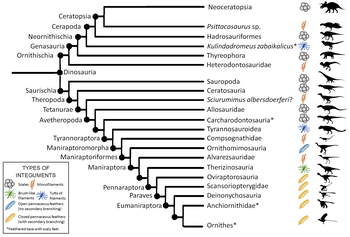
Fossil feather impressions are extremely rare and they require exceptional preservation conditions to form. Therefore, only a few non-avian feathered dinosaur genera have been identified. All fossil feather specimens have been found to show certain similarities. Due to these similarities and through developmental research, many scientists believe that feathers have only evolved once in dinosaurs. Feathers would then have been passed down to all later, more derived species, unless some lineages lost feathers secondarily. If a dinosaur falls at a point on an evolutionary tree within the known feather-bearing lineages, then its ancestors had feathers, and it is quite possible that it did as well. This technique, called phylogenetic bracketing, can also be used to infer the type of feathers a species may have had, since the developmental history of feathers is now reasonably well-known. All feathered species had filamentaceous or plumaceous (downy) feathers, with pennaceous feathers found among the more bird-like groups. The following cladogram is adapted from Godefroit et al., 2013.[49]
Phylogenetic bracketing can also be used to evidence the lack of feathered integument by inference. For example, the presence of scaly integument in a specific clade would be a strong indicator that members in the clade would share similar integument, as independent evolution of feathers multiple times is unlikely, regardless if fossil evidence is present for all genera within the clade.
Grey denotes a clade that is not known to contain any feathered specimen at the time of writing, some of which have fossil evidence of scales. The presence or lack of feathered specimens in a given clade does not confirm that all members in a clade have the specified integument, unless corroborated with representative fossil evidence within clade members.
| Neotheropoda |
| ||||||||||||||||||||||||||||||||||||||||||||||||||||||||||||||||||||||||||||||||||||||||||||||||||||||
See also
References
- Brown, Joseph W.; Van Tuinen, M. (2011). "Evolving Perceptions on the Antiquity of the Modern Avian Tree". Living Dinosaurs. pp. 306–324. doi:10.1002/9781119990475.ch12. ISBN 9781119990475.
- Farago, Jason (7 March 2019). "T. Rex Like You Haven't Seen Him: With Feathers". The New York Times. Retrieved 7 March 2019.
- Baron, Matthew G.; Norman, David B.; Barrett, Paul M. (23 March 2017). "A new hypothesis of dinosaur relationships and early dinosaur evolution". Nature. 543 (7646): 501–506. Bibcode:2017Natur.543..501B. doi:10.1038/nature21700. PMID 28332513.
- Yang, Zixiao; Jiang, Baoyu; McNamara, Maria E.; Kearns, Stuart L.; Pittman, Michael; Kaye, Thomas G.; Orr, Patrick J.; Xu, Xing; Benton, Michael J. (17 December 2018). "Pterosaur integumentary structures with complex feather-like branching" (PDF). Nature Ecology & Evolution. 3 (1): 24–30. doi:10.1038/s41559-018-0728-7. hdl:1983/1f7893a1-924d-4cb3-a4bf-c4b1592356e9. PMID 30568282.
- Greenwold, Matthew J.; Sawyer, Roger H. (September 2013). "Molecular evolution and expression of archosaurian β-keratins: Diversification and expansion of archosaurian β-keratins and the origin of feather β-keratins". Journal of Experimental Zoology Part B: Molecular and Developmental Evolution. 320 (6): 393–405. doi:10.1002/jez.b.22514. PMID 23744807.
- Huxley, T.H. (1868). "On the animals which are most nearly intermediate between birds and reptiles". Annals and Magazine of Natural History. 4th. 2: 66–75.
- Foster, Michael; Lankester, E. Ray 1898–1903. The scientific memoirs of Thomas Henry Huxley. 4 vols and supplement. London: Macmillan.
- Huxley, Thomas Henry (1877). "The Hypothesis of Evolution. The Neutral and the Favourable Evidence.". In Huxley, Thomas Henry (ed.). American Addresses, With A Lecture On Biology. New York: D. Appleton And Company.
- "1970s: Dinosaurs Redesigned". Paleoartistry. Retrieved 15 June 2017.
- Gierliński, G. (1996). "Feather-like impressions in a theropod resting trace from the Lower Jurassic of Massachusetts". Museum of Northern Arizona Bulletin. 60: 179–184.
- Kundrát, Martin (15 July 2004). "When did theropods become feathered?-evidence for pre-archaeopteryx feathery appendages". Journal of Experimental Zoology Part B: Molecular and Developmental Evolution. 302B (4): 355–364. doi:10.1002/jez.b.20014. PMID 15287100.
- Tetrapod Zoology @ScienceBlogs
- Turner, A. H.; Makovicky, P. J.; Norell, M. A. (21 September 2007). "Feather Quill Knobs in the Dinosaur Velociraptor". Science. 317 (5845): 1721. Bibcode:2007Sci...317.1721T. doi:10.1126/science.1145076. PMID 17885130.
- Norell M.A., Clark J.M., Chiappe L.M., Dashzeveg D.; Clark; Chiappe; Dashzeveg (1995). "A nesting dinosaur". Nature. 378 (6559): 774–776. Bibcode:1995Natur.378..774N. doi:10.1038/378774a0.CS1 maint: multiple names: authors list (link)
- Hopp, Thomas P.; Orsen, Mark J. (2004). "Dinosaur Brooding Behavior and the Origin of Flight Feathers". In Currie, Philip J.; Koppelhus, Eva B.; Shugar, Martin A.; Wright, Joanna L. (eds.). Feathered Dragons: Studies on the Transition from Dinosaurs to Birds. Indiana University Press. pp. 234–250. ISBN 978-0-253-34373-4.
- "Transcript: The Dinosaur that Fooled the World". BBC. Retrieved 22 December 2006.
- Bock, Walter J. (August 2000). "Explanatory History of the Origin of Feathers1". American Zoologist. 40 (4): 478–485. doi:10.1668/0003-1569(2000)040[0478:ehotoo]2.0.co;2.
- Emily Chung (12 September 2011). "Dinosaur feathers found in Alberta amber". CBC. Retrieved 16 September 2011.
- Switek, Brian (15 September 2011). "Amber inclusions showcase prehistoric feathers". Nature. doi:10.1038/news.2011.539.
- St. Fleur, Nicholas (8 December 2016). "That Thing With Feathers Trapped in Amber? It Was a Dinosaur Tail". The New York Times. Retrieved 8 December 2016.
- Romey, Kristin (8 December 2016). "First Dinosaur Tail Found Preserved in Amber". National Geographic Society. Retrieved 12 December 2016.
- Rincon, Paul (8 December 2016). "'Beautiful' dinosaur tail found preserved in amber". BBC News. Retrieved 8 December 2016.
- Xing, Lida; McKellar, Ryan C.; Xu, Xing; Li, Gang; Bai, Ming; Persons, W. Scott; Miyashita, Tetsuto; Benton, Michael J.; Zhang, Jianping; Wolfe, Alexander P.; Yi, Qiru; Tseng, Kuowei; Ran, Hao; Currie, Philip J. (December 2016). "A Feathered Dinosaur Tail with Primitive Plumage Trapped in Mid-Cretaceous Amber". Current Biology. 26 (24): 3352–3360. doi:10.1016/j.cub.2016.10.008. PMID 27939315.
- Voeten, Dennis F. A. E.; Cubo, Jorge; de Margerie, Emmanuel; Röper, Martin; Beyrand, Vincent; Bureš, Stanislav; Tafforeau, Paul; Sanchez, Sophie (13 March 2018). "Wing bone geometry reveals active flight in Archaeopteryx". Nature Communications. 9 (1): 923. Bibcode:2018NatCo...9..923V. doi:10.1038/s41467-018-03296-8. PMC 5849612. PMID 29535376.
- Guarino, Ben (13 March 2018). "This feathery dinosaur probably flew, but not like any bird you know". The Washington Post. Retrieved 13 March 2018.
- Stephen L. Brusatte, Graeme T. Lloyd, Steve C. Wang, Mark A. Norell (2014). "Gradual assembly of avian body plan culminated in rapid rates of evolution across the dinosaur-bird transition". Current Biology. 24 (20): 2386–2392. doi:10.1016/j.cub.2014.08.034. PMID 25264248.CS1 maint: uses authors parameter (link)
- Prum, R. & Brush A.H.; Brush (2002). "The evolutionary origin and diversification of feathers". The Quarterly Review of Biology. 77 (3): 261–295. doi:10.1086/341993. PMID 12365352.
- Prum, R (1999). "Development and evolutionary origin of feathers". Journal of Experimental Zoology. 285 (4): 291–306. doi:10.1002/(SICI)1097-010X(19991215)285:4<291::AID-JEZ1>3.0.CO;2-9. PMID 10578107.
- Xu, Xing; Norell, Mark A.; Kuang, Xuewen; Wang, Xiaolin; Zhao, Qi; Jia, Chengkai (October 2004). "Basal tyrannosauroids from China and evidence for protofeathers in tyrannosauroids". Nature. 431 (7009): 680–684. Bibcode:2004Natur.431..680X. doi:10.1038/nature02855. PMID 15470426.
- Norell, M. Xu, X. (2005) "The Varieties of Tyrannosaurs" Natural History Magazine May 2005.
- Dawson, Tj; Maloney, Sk (2013). "Fur versus feathers: the different roles of red kangaroo fur and emu feathers in thermoregulation in the Australian arid zone". Australian Mammalogy. 26 (2): 145. doi:10.1071/am04145.
- Dimond, C. C., R. J. Cabin and J. S. Brooks (2011). "Feathers, Dinosaurs, and Behavioral Cues: Defining the Visual Display Hypothesis for the Adaptive Function of Feathers in Non-Avian Theropods". BIOS. 82 (3): 58–63. doi:10.1893/011.082.0302.CS1 maint: uses authors parameter (link)
- Sumida, S. S.; C. A. Brochu (2000). "Phylogenetic Context for the Origin of Feathers". American Zoologist. 40 (4): 485–503. doi:10.1093/icb/40.4.486.
- Lingham-Soliar, T. (2011). "The evolution of the feather: Sinosauropteryx, a colourful tail". Journal of Ornithology. 152 (3): 567–577. doi:10.1007/s10336-010-0620-y.
- Vinther, J.; D. E. G. Briggs; R. O. Prum & V. Saranathan (2008). "The colour of fossil feathers". Biology Letters. 4 (5): 522–525. doi:10.1098/rsbl.2008.0302. PMC 2610093. PMID 18611841.
- Zhang, F. C., S. L. Kearns, P. J. Orr, M. J. Benton, Z. H. Zhou, D. Johnson, X. Xu X. L. Wang (2010). "Fossilized melanosomes and the colour of Cretaceous dinosaurs and birds" (PDF). Nature. 463 (7284): 1075–1078. Bibcode:2010Natur.463.1075Z. doi:10.1038/nature08740. PMID 20107440.CS1 maint: uses authors parameter (link)
- Zelenitsky, Darla K.; Therrien, Francois; Erickson, Gregory M.; DeBuhr, Christopher L.; Kobayashi, Yoshitsugu; Eberth, David A.; Hadfield, Frank (2012). "Feathered Non-Avian Dinosaurs From North America Provide Insight into Wing Origins". Science. 338 (6106): 510–514. Bibcode:2012Sci...338..510Z. doi:10.1126/science.1225376. PMID 23112330.
- Li, Q. G., K. Q. Gao, Q. J. Meng, M. D. Shawkey, L. D'Alba, R. Pei, M. Ellison, M. A. Norell and J. Vinther (2012). "Reconstruction of Microraptor and the Evolution of Iridescent Plumage". Science. 335 (6073): 1215–1219. Bibcode:2012Sci...335.1215L. doi:10.1126/science.1213780. PMID 22403389. S2CID 206537426.CS1 maint: uses authors parameter (link)
- Rauhut, Oliver W. M.; Foth, Christian; Tischlinger, Helmut; Norell, Mark A. (17 July 2012). "Exceptionally preserved juvenile megalosauroid theropod dinosaur with filamentous integument from the Late Jurassic of Germany". Proceedings of the National Academy of Sciences of the United States of America. 109 (29): 11746–11751. Bibcode:2012PNAS..10911746R. doi:10.1073/pnas.1203238109. PMC 3406838. PMID 22753486.
- Gould, Stephen J.; Vrba, Elisabeth S. (1982). "Exaptation: a missing term in the science of form" (PDF). Paleobiology. 8 (1): 4–15. doi:10.1017/S0094837300004310.
- Reichholf, J. H. (1996). "Die Feder, die Mauser und der Ursprung der Vögel. Ein neure Sicht zur Evolution der Vögel" [The feather, the moult and the origin of the birds. A new perspective on the evolution of birds]. Archaeopteryx (in German). 14: 27–38.
- Bock, Walter J. (1 August 2000). "Explanatory History of the Origin of Feathers". American Zoologist. 40 (4): 478–485. CiteSeerX 10.1.1.497.1279. doi:10.1093/icb/40.4.478.
- Mayr, Gerald; Peters, Stefan; Plodowski, Gerhard; Vogel, Olaf (2002). "Bristle-like integumentary structures at the tail of the horned dinosaur Psittacosaurus". Naturwissenschaften. 89 (8): 361–365. Bibcode:2002NW.....89..361M. doi:10.1007/s00114-002-0339-6. PMID 12435037.
- Zheng, Xiao-Ting; You, Hai-Lu; Xu, Xing; Dong, Zhi-Ming (2009). "An Early Cretaceous heterodontosaurid dinosaur with filamentous integumentary structures". Nature. 458 (7236): 333–336. Bibcode:2009Natur.458..333Z. doi:10.1038/nature07856. PMID 19295609.
- Xu, X.; Zheng, X.; You, H. (2009). "A new feather type in a nonavian theropod and the early evolution of feathers". Proceedings of the National Academy of Sciences. 106 (3): 832–4. Bibcode:2009PNAS..106..832X. doi:10.1073/pnas.0810055106. PMC 2630069. PMID 19139401.
- Godefroit, P; Sinitsa, S; Dhouailly, D; Bolotsky, Y; Sizov, A (2013). Feather-like structures and scales in a Jurassic neornithischian dinosaur from Siberia.
- Zhang, Fucheng; Zhou, Zhonghe; Xu, Xing; Wang, Xiaolin; Sullivan, Corwin (2008). "A bizarre Jurassic maniraptoran from China with elongate ribbon-like feathers" (PDF). Nature. 455 (7216): 1105–1108. Bibcode:2008Natur.455.1105Z. doi:10.1038/nature07447. PMID 18948955.
- Zelenitsky, D. K.; Therrien, F.; Erickson, G. M.; DeBuhr, C. L.; Kobayashi, Y.; Eberth, D. A.; Hadfield, F. (25 October 2012). "Feathered Non-Avian Dinosaurs from North America Provide Insight into Wing Origins". Science. 338 (6106): 510–514. Bibcode:2012Sci...338..510Z. doi:10.1126/science.1225376. PMID 23112330.
- Godefroit, Pascal; Cau, Andrea; Hu, Dong-Yu; Escuillié, François; Wu, Wenhao; Dyke, Gareth (2013). "A Jurassic avialan dinosaur from China resolves the early phylogenetic history of birds". Nature. 498 (7454): 359–362. Bibcode:2013Natur.498..359G. doi:10.1038/nature12168. PMID 23719374.
External links
- Dinosaur colour and feathers, University of Bristol, February 12, 2019
- DinoBuzz, dinosaur-bird controversy explained, by UC Berkeley.
- Feathered Dinosaurs on In Our Time at the BBC